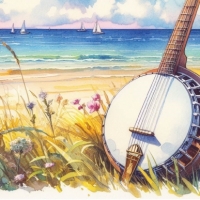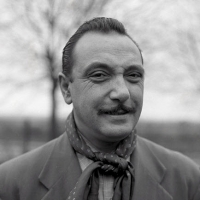DjangoBooks.com
Welcome to our Community!
Categories
- 20K All Categories
- 1.1K General
- 477 Welcome
- 59 Archtop Eddy's Corner
- 146 CD, DVD, and Concert Reviews
- 385 FAQ
- 26 Gypsy Jazz Italia
- 27 Photos
- 202 Gypsy Picking
- 21 Unaccompanied Django
- 15 Pearl Django Play-Along Vol.1
- 17 Gypsy Fire
- 45 Gypsy Rhythm
- 1.4K Gypsy Jazz University - Get Educated
- 131 Gypsy Jazz 101
- 227 Repertoire
- 220 History
- 708 Technique
- 51 Licks and Patterns
- 6 Daniel Givone Manouche Guitare Method Users Group
- 20 Eddie Lang Club
- 1.3K Gypsy Jazz Gear
- 802 Guitars, Strings, Picks, Amps, Pickups and Other Accessories
- 460 Classifieds
- 49 Recording
- 62 Other Instruments
- 18 Violin
- 5 Mandolin
- 22 Accordion
- 7 Bass
- 10 Woodwinds
- 348 Gypsy Jazz Events
- 143 North America
- 110 Europe
- 95 International
In this Discussion
Gypsy Rhythm: How loud should it be?
I was having a discussion/debate with another guitarist about how loud the gypsy rhythm should be. His take (from having taken a lesson with a couple famous players) was that you have to play all 6 strings on each beat, and that because of this, the rhythm is supposed to be loud.
I've always felt from a musical standpoint that the melody and soloist is the central part of the music and any rhythm should never cover it up. I know this to be true in all other styles of music and I can only assume it to be true in gypsy jazz as well. If the rhythm player is playing 6 strings and the soloist 1, then obviously there is a likelihood the rhythm will cover up a soloist if they are not careful. Also, different soloists have different dynamic range capabilities, so the rhythm player has to adjust to make sure they are "accompanying" and not forcing the soloist to play with more right hand force than they'd like to. I've watched/listened to a lot of different rhythm players, and the ones that I like such as Hono Winterstein and Nous'che Rosenberg do not seem to be playing all 6 strings all the time or hitting the strings with much force. Also, it doesn't seem to me that playing lightly and playing all 6 strings are mutually exclusive. I personally really like to have the option of playing a melody or solo with a wider dynamic range. If I'm struggling to be heard, then that forces me to play fortissimo and I end up not feeling like I can play musically. I've heard some gypsy rhythm that is very loud (mostly in jamming situations) and to my ears it sounds like the soloist is buried in rhythm and/or forced to play too hard.
Anyway, there must be other players thinking about these issues so I thought I'd post this debate. What are your opinions about how loud the gypsy rhythm should be and whether or not you need to play all 6 strings?
I've always felt from a musical standpoint that the melody and soloist is the central part of the music and any rhythm should never cover it up. I know this to be true in all other styles of music and I can only assume it to be true in gypsy jazz as well. If the rhythm player is playing 6 strings and the soloist 1, then obviously there is a likelihood the rhythm will cover up a soloist if they are not careful. Also, different soloists have different dynamic range capabilities, so the rhythm player has to adjust to make sure they are "accompanying" and not forcing the soloist to play with more right hand force than they'd like to. I've watched/listened to a lot of different rhythm players, and the ones that I like such as Hono Winterstein and Nous'che Rosenberg do not seem to be playing all 6 strings all the time or hitting the strings with much force. Also, it doesn't seem to me that playing lightly and playing all 6 strings are mutually exclusive. I personally really like to have the option of playing a melody or solo with a wider dynamic range. If I'm struggling to be heard, then that forces me to play fortissimo and I end up not feeling like I can play musically. I've heard some gypsy rhythm that is very loud (mostly in jamming situations) and to my ears it sounds like the soloist is buried in rhythm and/or forced to play too hard.
Anyway, there must be other players thinking about these issues so I thought I'd post this debate. What are your opinions about how loud the gypsy rhythm should be and whether or not you need to play all 6 strings?










Comments
As a pretty loud soloist, I like the rhythm to be fairly present, so that if I play a loud tremolo or gliss, I can still hear the accompaniment beneath me and we come out of it in the right place together - I have had experience with rhythm players playing so quietly ("sensitively"), that I can't use my full dynamic range for fear of overpowering them and not being able to hear the beat. Likewise, I think we've all suffered under - and at some stage probably been ourselves - overly loud rhythm players that limit the soloist in the other direction and obscure the lead line, which will never sound good.
So the answer, in my opinion, is that a good accompanist listens constantly and adjusts to whomever they playing with.
Soloists though, I think, should hold up their end of the bargain too, and be able to put out a reasonable volume level - if you're forcing your rhythm player to barely touch their guitar, that's not fair either, as it makes really swinging almost impossible.
Jon
that said, just because u hut all the strings does nit mean it has to be loud, with proper training and technique, yiu can easily control the volume without changing the tone of the rhythm
www.denischang.com
www.dc-musicschool.com
pas encore, j'erre toujours.
Well, Denis, for one. Not "should," but lays it out very well that as an option in his DVD. I believe Denis does teach that as one approach for beginners..always easier to "pull back" (this, or dynamics) perhaps, then start clanging on the bass strings and later develop a smooth attack, on whatever strings one chooses to use in accompaniment. That's my read of what Denis teaches, anyway. Fapy sounds to me like he does this, largely, plays all strings.
I can only speak to Stochelo, Hono and Nous'che (and that, from videos only), but yep, that's my observation as well. But it's important to say, "bass strings on beats 1 and 3," because on beats 2 and 4, the percussive beats, they're hitting all the strings.
Again, my observation only, but I think there is a distinction here between beats 1 and 3 on the one hand, and beats 2 and 4. Took me quite awhile, and I may still be wrong, but Nous'che is very "square" on beats 1 and 3, from my study of him. Very dry, very square, and not arc'ing - which he clearly does on beats 2 and 4. The full "thwack" of these beats, it's natural for the wrist to fly, and arc.
I see this alot, mostly in "new wave" players, meaning, younger guys who have been influenced by the current Parisian movement, for want of a better term, in playing.
If you're talking about the DC videos, yep, he does talk about this. Basically, he's talking about changing the style of accompaniment to suit the needs of the soloist - in this case, Bireli Lagrene, who I understand showed Hono this technique. Much straighter wrist, indeed, muting the strings with his right hand. One method, a "modern" sound, in an arsenal of accompaniment techniques.
Paul
pas encore, j'erre toujours.
btw the hono videos have english subtitles...
www.denischang.com
www.dc-musicschool.com
Okay, not to state the absolute obvious, but I assume you are aware that Gypsy jazz rhythm guitarists are essentially playing the role of the drummer. The Pompe', if I'm not mistaken, is a mimic of the classic swing High hat ride.
So comparing gypsy jazz with other types of music in terms of the rhythm guitar makes little sense unless its a musical style where the rhythm guitar is serving the role of drummer as well.
So perhaps a more important question is "how loud do I like my drummer to play?"
Anthony
Jon
Jeez, um, er, really? That would be an absolute first, Denis! Now, if only I could play as much as I can observe, and talk, hahahah.
pas encore, j'erre toujours.